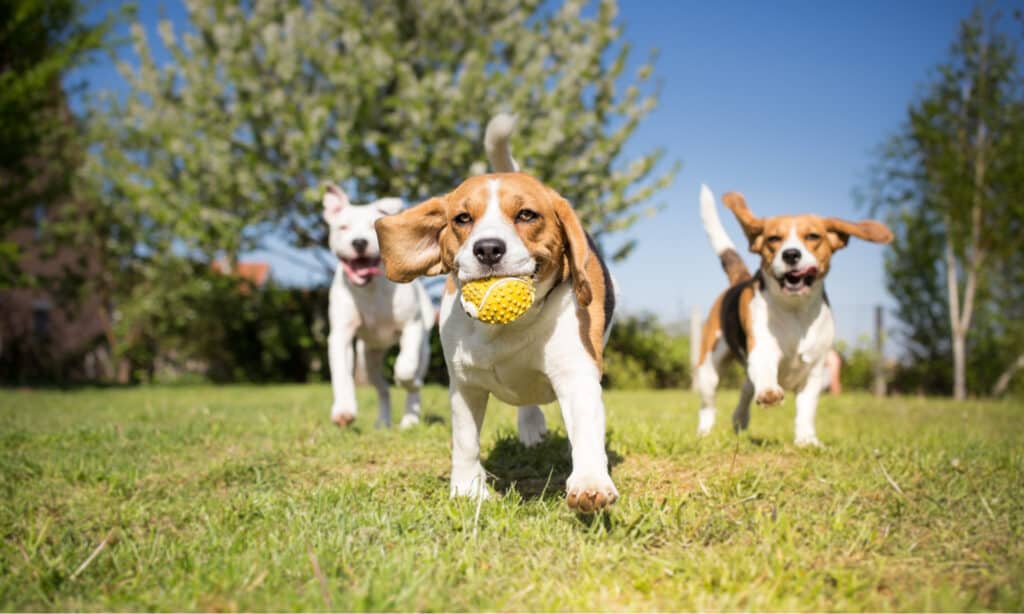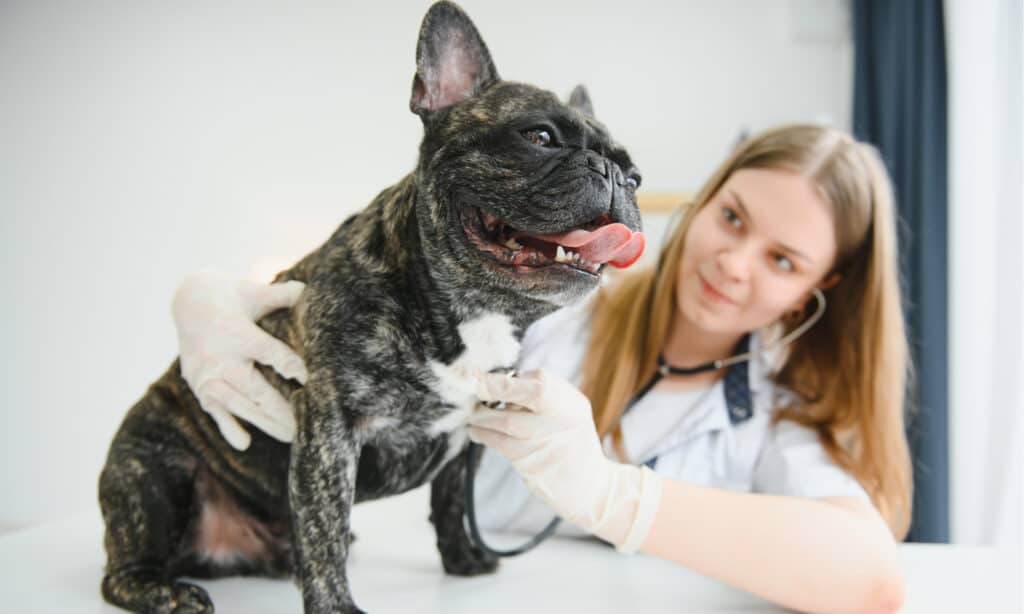No one wants their doggie to be sick, but sometimes it happens. You may look at your pup on long walks after freshly applied sunscreen and wonder if they are safe from the sun. Then as with most dog owners, you dreadfully think of the worst possible situation that could happen.
You ask yourself if dogs can get skin cancer. Unfortunately, they can, and there are a few types they can get. Some dogs are also more at risk for skin cancer based on their breed.
You can be prepared just in case your dog has any risk factors. You’ll learn which dogs are most likely to get it, their symptoms, and more in the following post. Keep reading to keep your doggie healthy.
How Do Dogs Get Skin Cancer? What Types?
Which canines are more prone to developing skin cancer is mainly determined by genetics. Skin cancer in dogs can also be caused by excessive sun exposure, environmental toxins, hormone imbalances, and specific viruses.
Similar to several skin layers, dogs have various forms of skin cancer. Different tumors may form in each layer and skin component, some of which may progress to cancer. Some common types of skin cancer in dogs are:
- Fibrosarcoma
- Malignant melanoma
- Squamous cell carcinoma
- Mast cell tumors
- Histiocytic cell tumors

Unfortunately, dogs can get skin cancer. This depends on their genetics.
©oneinchpunch/Shutterstock.com
Fibrosarcoma
Fibrosarcoma and spindle cell tumors start in the skin’s connective tissues and under the skin. These tumors can look different, and even though they usually grow slowly, they often return after surgery to remove them. Rarely does this kind of tumor spread to other bodily regions.
Most dogs get fibrosarcoma when they are in their middle years or older. The average age at this happens ten years. Young dogs can sometimes get fibrosarcoma that grows quickly and spreads. Your vet will send a piece of the tumor to a pathologist to find out if it is a low-grade or high-grade tumor, which is a classification based on how fast the cells divide.
This will help them figure out what’s wrong with your dog and how to treat it. This kind of tumor is common in the limbs. The tumors can grow into nearby structures and sometimes stop them from working. They can also bleed, get sores, and get infected.
Melanoma
Melanomas can either be cancerous or not. Most of the time, these tumors are dark or have no color. Malignant melanomas are dangerous because they grow quickly and have a greater risk of spreading to other organs. Most malignant melanomas happen on the lips, in the mouth, and on the nail beds.
Researchers say that the head, neck, and scrotum are also moderately likely to get skin cancer. Some breeds, like Schnauzers and Scottish Terriers, are more likely to get it, and it seems like males are more likely to get it than females. Malignant melanomas look like raised, often ulcerated bumps.
They can also look like gray or pink bumps in the mouth. Nail bed malignant melanomas, on the other hand, cause the toe to swell and may even cause the toenail to fall off and the bone beneath it to break down. Tumors in the nail bed or footbed often get another infection, leading to a wrong diagnosis. Most of the time, these tumors spread to other body parts, making a good outcome less likely.
Squamous cell carcinoma
This is the most frequent form of skin cancer that’s diagnosed. Older dogs, especially Standard Poodles, Basset Hounds, and Blood Hounds, are most likely to get it. These tumors are often found on the head, lower legs, back, or abdomen as hard raised patches or lumps.
Scientists think the papillomavirus may also be linked to some dogs’ growth of squamous cell tumors. Cancers of the squamous cells can spread to lymph nodes nearby. They grow quickly and may cause the tissue around the tumor to die.
Different things can happen to dogs with squamous cell carcinomas. The outlook is good for dogs with well-differentiated tumors that can be removed entirely and haven’t spread. The outlook is bad for dogs with tumors that can’t be removed, aren’t well-differentiated, or have spread.
Mast Cell Tumors
Most skin tumors in dogs come from the immune system’s mast cells, which are the source of these types of cancer. It can grow on any part of your dog’s skin or organs, but it usually happens on the limbs, lower abdomen, and chest.
Vets don’t understand what causes this type of cancer to form, but in some cases, they have been linked to skin inflammation or irritation. There is evidence that genetics often play a role, and estrogen and progesterone hormones may also affect cancer growth. These dog breeds are most likely to get it:
- Older mixed dog breeds
- Rhodesian ridgebacks
- Pugs
- Boxers
- Boston terriers

The Rhodesian Ridgeback is an example of a breed vulnerable to mast cell tumors.
©olgagorovenko/Shutterstock.com
Histiocytic Cell Tumors
These skin cells can grow into tumors common in dogs younger than three years old. Histiocytic cell tumors are made up of these cells that have grown out of control and turned into lumps. Th
There are three types of these cell tumors: histiocytomas, which are more common, systemic histiocytosis, which primarily affects Bernese Mountain Dogs, and malignant histiocytosis, which mainly affects Bernese Mountain Dogs and starts in the organs.
Other dogs at risk are:
Signs and Symptoms of Skin Cancer in Dogs
The symptoms of skin cancer heavily depend on the type, but in general, keeping an eye out for any odd lumps or bumps on your dog’s body, especially as he ages, is the best way to catch it early. Not all skin growths are malignant. For instance, skin tags are typically benign lipomas or sebaceous cysts.
But it’s best to be safe and notify your veterinarian if you notice a weird lump or region of discoloration. Concern should also be expressed in growth or lump changes in size, shape, color, or develops an ulcer. The only way to determine whether a dog has skin cancer is to look at the cells within a skin tumor or lesion.
Your pet’s veterinarian may perform a biopsy to remove a small tumor fragment or lesion or use a method called fine needle aspiration to collect a small sample of cells. These samples are typically sent to pathology to determine the proper diagnosis.
Treatment Options for Canine Skin Cancer
The symptoms of skin cancer heavily depend on the type, but in general, keeping an eye out for any odd lumps or bumps on your dog’s body, especially as he ages, is the best way to catch it early. Not all skin growths are malignant.
For instance, skin tags are typically benign lipomas or sebaceous cysts. But it’s best to be safe and notify your veterinarian if you notice a weird lump or region of discoloration. Concern should also be expressed in growth or lump changes in size, shape, color, or develops an ulcer.
The only way to determine whether a dog has skin cancer is to look at the cells within a skin tumor or lesion. Your pet’s veterinarian may perform a biopsy to remove a small tumor fragment or lesion or use a method called fine needle aspiration to collect a small sample of cells. These samples are typically sent to pathology to determine the proper diagnosis.

If your dog has skin tags, it’s best to bring him to the vet for a check-up. Only a veterinarian can tell if the skin tags are cancerous or benign.
©Hryshchyshen Serhii/Shutterstock.com
Prevention Tips for Keeping Your Dog Safe from Skin Cancer
While certain diseases cannot be prevented, others can. Many cancers, like those in people, are caused by a genetic predisposition. In other cases, several unlucky factors may come together to give your dog cancer.
Reducing the risk of skin cancer is done mainly one way. Exposure to sunlight is the risk factor that you have the most influence over. Limiting your dog’s exposure to direct sunlight, especially at the height of the day, may help reduce his chance of developing skin cancer if you have a light-skinned and short-haired dog breed.
However, becoming familiar with all of your dog’s lumps, bumps, and rashes, possibly through your daily grooming routine, is the most crucial thing you can do to help your dog avoid skin cancer. If you find anything suspicious, contact your veterinarian right away.
Conclusion
As a dog owner, it’s vital to be aware of the signs of skin cancer if your dog is at risk. However, there are a few things to help keep your dog safe. The most important thing is to watch for the signs of skin cancer.
If you find any odd changes in your dog’s skin, such as new growths or discoloration, take them to the vet immediately. Early detection is key to getting treatment and ensuring a positive outcome. You can also help to prevent skin cancer by limiting your dog’s exposure to sunlight.
When going out in the sun for an extended period, make sure to provide shade and sunscreen for your dog. Taking these steps can help keep your furry friend safe and healthy. Share this article if you know someone with a pup mentioned on this list. It could help save a life.
Up Next:
- Can Dogs Get Pink Eye, How Do You Treat It?
- Can Dogs Get COVID-19? Symptoms, Risks, and Prevention
- This is How Dogs Get Rabies, and What to Do If They Catch it
The photo featured at the top of this post is © CI Photos/Shutterstock.com
Ready to discover the top 10 cutest dog breeds in the entire world?
How about the fastest dogs, the largest dogs and those that are -- quite frankly -- just the kindest dogs on the planet? Each day, AZ Animals sends out lists just like this to our thousands of email subscribers. And the best part? It's FREE. Join today by entering your email below.
Sources
- , Available here: https://www.guilfordjamestownvet.com/site/blog-greensboro-vet/2020/05/29/skin-cancer-dogs
- , Available here: https://www.bluecross.org.uk/advice/dog/skin-cancer-in-dogs
- , Available here: https://www.thedodo.com/dodowell/skin-cancer-in-dogs
- , Available here: https://blog.healthypawspetinsurance.com/dog-skin-cancer
Thank you for reading! Have some feedback for us? Contact the AZ Animals editorial team.






